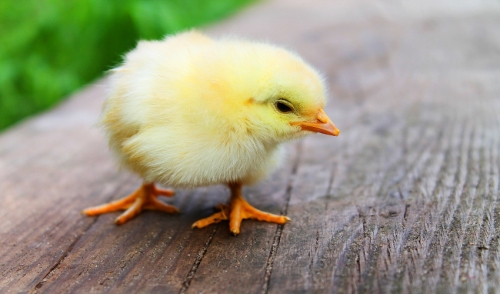{article.name}
Tips for Creating a Living Space for your Baby Chicks

- Share this:
- Share on Facebook
- Pin on Pinterest
- Tweet on Twitter
Newly hatched chicks, ducklings, goslings and turkey poults require that their very basic needs for shelter, warmth, food and water be met in order to survive. Good care and management with a bit of TLC will go a long way in providing a healthy start for your young flock. Following are some useful tips to make sure you get your new arrivals started off on the right foot this spring.
- Baby chicks need a house that is clean, warm and dry. Chicks need 0.8 – 1.0 square feet of floor space per chick during the first 6 weeks of age. Ducklings, goslings and turkey poults will require more space due to their larger size. The normal brooding period for chicks begins when they hatch until they reach about 6 weeks of age. A commercially made brooder may be available from your Purina Mills Dealer. Small numbers of chicks can be temporarily housed in a sturdy cardboard box equipped with infrared heat lamps for warmth. Brooders should be placed in an area that offers protection from the elements, is well ventilated (but free from drafts), and safe from predators. Commercial brooders should be thoroughly cleaned and disinfected several days prior to the arrival of your chicks.
- The heat source in the brooder should be adjusted to provide a 90°F temperature (at chick level) one day prior to arrival of the chicks. Turkeys require a higher brooder temperature of 100°F to start. Your chicks will require less heat as time goes by and they grow larger and more able to regulate their body temperature. The brooder temperature should be reduced by 5° each week after the first week to a minimum of 65°F.
- When using a cardboard box to start chicks, an infrared heat lamp placed about 20 inches above the surface of the litter will provide a good source of heat. It’s a good idea to use two lamps in case one fails so that the chicks don’t get chilled. Be very careful to position the lamp so it does not touch the box or any other object and create a fire hazard. The lamp height can be adjusted up or down to achieve the desired 90°F.
- Three to 5 inches of dry pine shavings, straw or other absorbent litter (bedding) should be placed on the brooder floor. Paper towels can be used to cover the litter for the first several days to prevent chicks from mistaking the litter as food. Newspaper and flat cardboard can be slick and should not be used as it can cause leg problems in chicks.
- A brooder guard ring (cardboard, plastic or wire barrier) can be placed around the brooding area for the first several days to keep the chicks close to the source of heat. If not used, the chicks may stray too far from the warmth and get chilled. The guard also prevents the chicks from crowding into corners and smothering. Provide enough space for chicks to move away from the heat if they get too warm. After a few days, the chicks will have learned where to find warmth and the guard can be removed.
- Equip brooder with waterers and feeders which are available in several different sizes and shapes to fit your particular needs.
- Water is critical for proper growth and development of chicks. Fresh, clean water needs to be available at all times.
- Purina Mills Start & Grow® SunFresh® Recipe should be fed free-choice until chicks reach laying age (18-20 weeks). This complete and balanced diet will provide everything that your chicks need to grow and develop into mature birds. For mixed flocks containing chicks, ducklings and goslings, Purina Mills Flock Raiser® SunFresh® Recipe should be fed free-choice from hatch until laying age. Turkey poults require a higher protein diet initially and should be fed Purina Mills Game Bird Chow® Startena® free-choice from hatch until they are 8-10 week of age. After this time, they can be fed Purina Mills Flock Raiser® SunFresh® Recipe until laying age at 18-20 weeks.
- When you bring your chicks home, place them gently under the warm brooder. Dipping the beaks of a few chicks into the water will help them find it sooner and the others will quickly catch on. When starting turkeys, be aware that they are not as quick to pick up on the mechanics of eating and drinking and may need some extra instruction! During the first few days, use shallow pans, egg flats or squares of paper as temporary feeders. Small piles of feed placed on them will allow the chicks to find the feed more easily and start eating earlier. On the second day, regular feeders can be introduced. The feeding area should be big enough to allow all chicks to eat at the same time. Keep feeders full the first week. The level of feed in the feeders can be decreased a little each week after this until they are 1/2 full at all times which will help reduce the amount of feed waste.
- Provide chicks with 18 hours of light per day for the first week and at least 10 hours per day thereafter (natural light counts).
- Keep it clean and dry! Wet feed and litter is a breeding ground for disease and a quick recipe for disaster! Spilled water should be cleaned up to prevent dampness in the brooder house and wet or caked litter removed as necessary and replaced with clean, dry litter. Disease can strike and spread rapidly between chicks if they eat contaminated feed or water so be sure to keep feeders and waterers free of litter and droppings. Thoroughly clean and refill waterers daily or more often if necessary. Feeders should get a good cleaning weekly and more frequently if needed.
- Prevent chicks from chilling or getting too hot! The best measure to determine if the temperature in the brooder is correct is how your chicks behave. If right on target, the chicks will be evenly dispersed. Chicks that huddle together under the heat source are cold. Overheated chicks will station themselves around the edges of the box or brooder guard, and may pant. The temperature should be increased or decreased accordingly by raising or lowering the lamps or adjusting the heat source.

Following the tips above will help you to get through the most labor-intensive part of starting your flock. Before you know it, your fuzzy chicks will be fully feathered and mature enough to leave the brooder and move into more permanent living quarters, the chicken coop. If you don’t have one already, now is a good time to start looking into getting one and preparing it for new occupants. You’ll be surprised at how fast your chicks will grow and how quickly moving day will arrive! Many types of poultry housing are available for purchase or you can venture to build your own. Whatever you decide, make sure that the house you choose is ventilated, predator proof and provides protection from extreme temperatures, wind and rain. Visit the Purina Mills poultry website where plans are available for a hen house and hutch design. You’ll also find a wealth of information on feeding and raising poultry that will be useful as your chicks develop into mature, productive birds.
Special Offers
We are constantly adding new specials to our site. Be sure to check back often!



Comments